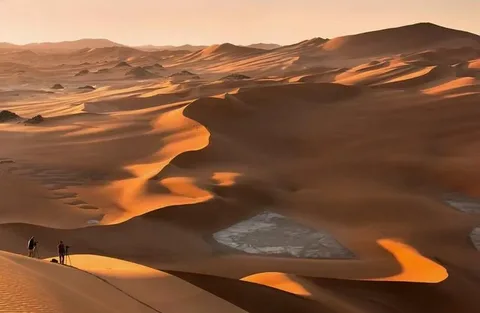Introduction to the Sahara and Gobi Deserts
Welcome to the battle of the deserts – Sahara vs. Gobi! These majestic landscapes boast extreme beauty and unique characteristics that set them apart from each other. If you’re curious to learn about the distinctions between these two iconic deserts, buckle up as we embark on a thrilling journey through their contrasting features, climates, wildlife, and more. Let’s dive in and unravel the mysteries of the Sahara Desert and the Gobi Desert!
Location and Size Comparison
The Sahara Desert, located in North Africa, is the largest hot desert in the world. It stretches over 3.6 million square miles, covering most of Northern Africa. In comparison, the Gobi Desert is situated in northern China and southern Mongolia. Although smaller than the Sahara, it still spans an impressive area of about 500,000 square miles.
The vast expanse of the Sahara includes countries like Morocco, Algeria, Tunisia, Libya, Egypt, Mauritania, Mali, Chad, and Sudan. On the other hand, the Gobi Desert covers parts of China’s Inner Mongolia region and extends into southern Mongolia.
Despite their size difference – with the Sahara being significantly larger – both deserts are unique in their landscapes and offer distinct experiences to travellers seeking adventure amidst dunes or rocky terrains. The diversity between these two deserts makes each one a fascinating destination worth exploring for anyone craving a taste of extreme environments.
Climate and Weather Patterns
The climate and weather patterns of the Sahara and Gobi Deserts are as distinct as the landscapes themselves. The Sahara Desert is known for its scorching heat, with temperatures reaching up to 122°F (50°C) during the day and dropping significantly at night. It experiences very little rainfall, making it one of the driest places on Earth.
On the other hand, the Gobi Desert has a more extreme climate characterized by harsh winters with temperatures plummeting below freezing, while summers can be hot with temperatures exceeding 104°F (40°C). Unlike the Sahara, the Gobi receives some precipitation in sporadic bursts, which supports sparse vegetation in certain areas.
Both deserts exhibit drastic temperature fluctuations between day and night due to their lack of humidity. These unique weather patterns play a crucial role in shaping the ecosystems and life forms that have adapted to survive in these challenging environments.
Flora and Fauna in Each Desert
The Sahara Desert is known for its sparse vegetation, with tough and resilient plant species adapted to the harsh conditions. Cacti, acacias, and date palms can be found scattered throughout the desert landscape. In terms of fauna, animals like camels, fennec foxes, and addaxes have evolved unique features to survive in this arid environment.
On the other hand, the Gobi Desert showcases a different array of flora and fauna. You can spot saxaul trees with their deep roots that search for water deep underground. The Gobi is also home to snow leopards, Bactrian camels, and jerboas – each uniquely adapted to thrive in this cold desert habitat.
Both deserts may seem barren at first glance but are teeming with life specially suited to their respective climates.
Human Inhabitants and History of the Deserts
The Sahara Desert has a long history of human inhabitants dating back thousands of years. It has been home to various civilizations and nomadic tribes who have adapted to the harsh desert conditions. From the ancient Egyptians to the Berber people, the Sahara holds a rich tapestry of human history.
On the other hand, the Gobi Desert boasts its own unique stories of human survival and resilience. Nomadic herders such as the Mongolians have traversed this vast expanse for centuries, relying on their knowledge of the land and resourcefulness to thrive in such extreme environments.
Both deserts hold valuable insights into how humans can adapt and coexist with nature in some of Earth’s most challenging landscapes. The histories of these deserts are testaments to human ingenuity and perseverance in the face of adversity.
Tourist Attractions in Sahara and Gobi
When it comes to tourist attractions, both the Sahara and Gobi Deserts offer unique experiences that cater to different interests. In the Sahara Desert, visitors can marvel at the stunning dunes of Erg Chebbi in Morocco or explore ancient desert towns like Merzouga. The opportunity to go on a camel trek and camp under the stars is an unforgettable experience for many travellers.
On the other hand, the Gobi Desert in Mongolia presents a distinct landscape with its rocky mountains, vast steppes, and dramatic cliffs. Tourists flock to witness the famous Flaming Cliffs where dinosaur fossils have been discovered or visit Eagle Valley for breathtaking scenery ideal for hiking enthusiasts.
While both deserts provide nature lovers with ample opportunities for exploration and adventure, each offers a unique cultural experience that sets them apart from one another.
Conclusion: Which Desert is Right for You?
When deciding which desert to visit, consider your preferences and interests. If you crave vast expanses of dunes and impressive landscapes, the Sahara Desert might be your ideal destination. On the other hand, if you are drawn to unique rock formations, diverse ecosystems, and a more extreme climate experience, then the Gobi Desert could be the perfect choice for you.
Both deserts offer unparalleled opportunities for adventure and exploration. Whether you dream of riding camels across endless sands or discovering dinosaur fossils in rocky terrains, each desert has its charm and allure.
The decision of which desert is right for you depends on what kind of experience you seek. Whichever one you choose to explore – whether it’s the Sahara with its iconic dunes or the Gobi with its mysterious beauty – prepare yourself for an unforgettable journey into some of nature’s most intriguing landscapes.

















